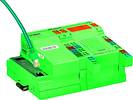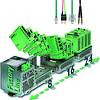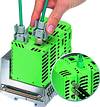
The application of Ethernet in automation is continuing to grow and its use is becoming increasingly widespread. The number of Ethernet users has been rising constantly since the introduction of a control cabinet-compatible infrastructure that includes suitable cables and easy-to-use start-up tools. Even conventional applications such as the transmission of process data are being implemented more and more frequently with Ethernet technology thanks to Ethernet-compatible I/O systems (Figure 1). However, the aim of making Ethernet suitable for use in all areas of automation has not yet been achieved. This is currently due, in part, to the high overall cost of the Ethernet infrastructure and the fact that many users require a higher level of performance in terms of realtime capability and diagnostics.

In terms of the general use of Ethernet, an essential factor is the common assumption among users that because Ethernet has recently become widespread, products are being ordered in large quantities and prices have therefore dropped accordingly.
The large number of users promotes variety and innovation on the market. However, there has recently been a general realisation that Ethernet products on the mass office communications market are often unable to meet user requirements. Although more rugged infrastructures in terms of EMC, vibration, temperature range or resistance to harsh environmental conditions are available, they are more expensive. Active components that can be distributed in the system (eg, switches) are the first major step towards significantly reducing overall infrastructure costs in comparison with the cost of conventional cabling structures in spite of increased device prices. Money saved by eliminating central control cabinets and reducing expensive cabling based on star topologies often more than pays for the increased price of an infrastructure that is suitable for industrial use (active components). However, there are other ways of reducing costs.
Integrated medium converters and polymer fibres
In Ethernet networks, transitions from fibre-optic cables to copper cables are commonplace. This means that both the active infrastructure and termination devices must provide one or more ports in the appropriate medium. Combinations used previously, eg, switches with TX ports and medium converters, are approximately 30% more expensive, need more space, and require more energy than directly implemented FX ports. Even in the mass-produced market, there is a considerable difference in price between TX and FX ports. On this basis, there are grounds for arguing against the use of fibre-optics by end users. In terms of increased immunity to interference (EMC) - polymer fibres can provide the same level of immunity but cost considerably less and are easier to assemble.
Reduced installation times
In this respect, optimised automation products are nothing new - the key is to convert these designs for use in Ethernet network products. Essential product features include DIN rail mounting, plug-in connectors, local port LEDs that can be read once cables have been connected, and the ability of devices to perform self-diagnostics and display results (locally and, eg, centrally as a visualised SNMPtrap).
Maximum availability
The availability of electronics is determined primarily by quality of design and manufacture as well as ruggedness in respect of EMC, temperature range, shock, vibration, etc. Of secondary importance are complexity of operation and availability, in terms of installation and start-up and, if applicable, in the event that products need to be serviced or replaced. The above factors are generally more relevant than redundancy, on which too much emphasis is often placed. It is an undisputed fact that cable defects are the most common cause of system downtimes. Although redundancy mechanisms can provide security, redundancy is expensive. Preventive device self-diagnostics are a more cost-effective solution and also offer additional security and assistance in locating the source of problems.
High levels of flexibility
Costs can be reduced if functions are flexible and the same product can be used in a wide variety of different applications. This applies to flexibility not only in terms of the number of ports but also in the selection of media and the possibility of housing ports in both control boxes and terminal boxes. Flexibility also reduces training and logistical costs.
The result: the modular managed switch (MMS)
All the possible ways of reducing the overall cost of Ethernet networks outlined above influenced the development of the Phoenix Contact Factory Line switch (Figure 2), which meets the four basic requirements of automation: rugged design, intelligence, and flexibility combined with ease-of-use.

Able to meet all connection requirements in terms of the number of ports, connectors, and transmission medium, the MMS is the solution for a large number of Ethernet installation tasks. It can be expanded seamlessly from eight ports to up to 24 ports. Two-port interface modules mean that cables can be routed either via the housing base or the front face. The switch supports twisted pair, glass fibres or less expensive polymer and HCS fibres (Figure3). The compact dimensions of the switch (it is just 110 mm deep) make applications in terminal boxes possible for the first time. The RJ-45 ports can be connected using standard RJ-45 cables or protected against mechanical stress, shock, and vibration with the various connector (Figure 3). The easy-to-assemble polymer fibres are now also compatible with Fast Ethernet, meaning that cost-effective fibre-optic cables, connectors, and interfaces can be used.

Managed switches - the way to Ethernet realtime capability
Although Ethernet can be used in many applications, it has not yet been possible to use it for process data communication in applications with increased realtime requirements (response times of several ms, determinism). It is also a known fact that 'switched Ethernet' is deterministic at MAC level provided that switching technology with full duplex connections is used universally in order to avoid collisions. This gives rise to one of the most important requirements, namely the ability to calculate the maximum transmission time in advance.
Other mechanisms for increasing realtime capability include VLANs (virtual LANs) and prioritising. VLANs create broadcast domains, therefore restricting unnecessary data loads. The prioritising of data packets prevents data traffic that has been assigned a higher priority (eg, time-sensitive process data) being damaged by lower-priority data traffic (eg, non-time-critical parameter settings) in the event of large volumes of data traffic. Both functions need activating/deactivating or configuring, hence the urgent requirement for managed switches.
Summary: Factory line MMS management functions
The MMS supports both SNMP and web-based management. This means that it can provide detailed diagnostic and configuration options for start-up, normal operation, and in the event of errors, as well as numerous types of network and device information. Data is displayed clearly in the Factory Manager, which is also used as a central tool for addressing purposes.
For more information contact Rob MacKenzie, Phoenix Contact, 011 793 7121, [email protected]
| Tel: | +27 11 801 8200 |
| Email: | [email protected] |
| www: | www.phoenixcontact.co.za |
| Articles: | More information and articles about Phoenix Contact |

© Technews Publishing (Pty) Ltd | All Rights Reserved